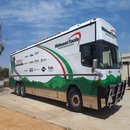T1 Terry
240vac soldering iron on an inverter
-
T1 Terry

- Posts: 16623
- Joined: Fri Nov 23, 2012 3:44 pm
- Location: Mannum South Australia by the beautiful Murray River
- Has thanked: 75 times
- Been thanked: 58 times
240vac soldering iron on an inverter
Saw something on that other forum where someone was asking about using a soldering iron on an inverter. If the inverter has an earth to the vehicle body then there will be a battery voltage short across the tip when ever you try to solder a live positive connection. The reason is the soldering iron tip is connected to the earth wire and if that is connected to the body some where further down the wiring harness, so is the battery negative. The nice fine tip on the soldering iron doesn't last very long when it pulls an arc across the tip 
T1 Terry
T1 Terry
A person may fail many times, they only become a failure when they blame someone else John Burrows
Those who struggle to become a leader, rarely know a clear direction forward for anyone but themselves
Those who struggle to become a leader, rarely know a clear direction forward for anyone but themselves
-
supersparky

- Posts: 9092
- Joined: Mon Nov 26, 2012 7:00 pm
- Location: Home on the beautiful Gold Coast for a while.
- Has thanked: 115 times
- Been thanked: 92 times
Re: 240vac soldering iron on an inverter
It is a bit of a catch 22 isn't it. Another good reason to use a gas powered soldering iron, or a butane heating torch.
Cheers
David
David and Terrie
2006 Winnebago Alpine
Not all who wander are lost.
David
David and Terrie
2006 Winnebago Alpine
Not all who wander are lost.
-
dapope

- Posts: 2019
- Joined: Fri Nov 23, 2012 2:43 pm
- Location: N.F.A.
Re: 240vac soldering iron on an inverter
I have a little battery powered one. Jaycar. Does the job
Wobblybox on wheels
Pace Arrow. La de da, property in two continents..
Pace Arrow. La de da, property in two continents..
-
Toolman

- Posts: 242
- Joined: Sat Jul 19, 2014 9:11 pm
- Location: Geraldton WA
-
Peter and Sandra
- Posts: 254
- Joined: Tue Dec 11, 2012 3:39 am
- Location: Dungog NSW
- Been thanked: 2 times
Re: 240vac soldering iron on an inverter
They only do it once  )
)
Oka 4WD camper/motorhome, 1100w solar, 400ah lithium, diesel heating, HWS and cooking
-
bagmaker
- Posts: 886
- Joined: Sun Jan 20, 2013 4:56 pm
- Location: Victoria
Re: 240vac soldering iron on an inverter
so I am leaning on the bus body, about to feed solder into the wire, inverter driven iron in other hand- what happens? Shock time?
I actually withdrew myself from the exact same scenario last week as I wasnt sure and had a mains option, it just didnt sit right with me, trying to solder a big lug to a battery cable. Interesting
I actually withdrew myself from the exact same scenario last week as I wasnt sure and had a mains option, it just didnt sit right with me, trying to solder a big lug to a battery cable. Interesting
-
BruceS

- Site Admin
- Posts: 9445
- Joined: Thu Nov 22, 2012 7:32 pm
- Location: Nebo, Qld
- Has thanked: 67 times
- Been thanked: 53 times
Re: 240vac soldering iron on an inverter
The wire isn't 'live' in the sense of 240v but it is on the inverter input voltage.
I had a 48v inverter & Terry will tell you what happened to the copper end of the soldering iron!!!
Try it & find out?
I had a 48v inverter & Terry will tell you what happened to the copper end of the soldering iron!!!
Try it & find out?
*******************
BruceS
Nebo, Qld
********************
BruceS
Nebo, Qld
********************
-
jon_d

- Posts: 4957
- Joined: Thu Apr 11, 2013 6:37 pm
- Location: bedford
- Has thanked: 48 times
- Been thanked: 62 times
Re: 240vac soldering iron on an inverter
Who has an inverter where the neutral is tied to earth? Most are isolated.
-
bagmaker
- Posts: 886
- Joined: Sun Jan 20, 2013 4:56 pm
- Location: Victoria
-
jon_d

- Posts: 4957
- Joined: Thu Apr 11, 2013 6:37 pm
- Location: bedford
- Has thanked: 48 times
- Been thanked: 62 times
Re: 240vac soldering iron on an inverter
Get your licensed electrician to test it - with everything turned off. (and double checked and tripled checked that everything is off.)
Measure the DC resistance between earth and neutral when:
1. the power cord is removed from the bus to mains AND
2. the change over switch is switched to the inverter.
(Being a DC measurement across a transformer, you can measure earth to active too.)
Wayne, if your sparkie has done his job properly, it should be switched in under certain conditions. It's documented in the standards.... but many don't do it.
Just a reminder this forum is open so be careful what you post about electricity. sometimes you need to speak generally and not give definitive advice.
Measure the DC resistance between earth and neutral when:
1. the power cord is removed from the bus to mains AND
2. the change over switch is switched to the inverter.
(Being a DC measurement across a transformer, you can measure earth to active too.)
Wayne, if your sparkie has done his job properly, it should be switched in under certain conditions. It's documented in the standards.... but many don't do it.
Just a reminder this forum is open so be careful what you post about electricity. sometimes you need to speak generally and not give definitive advice.